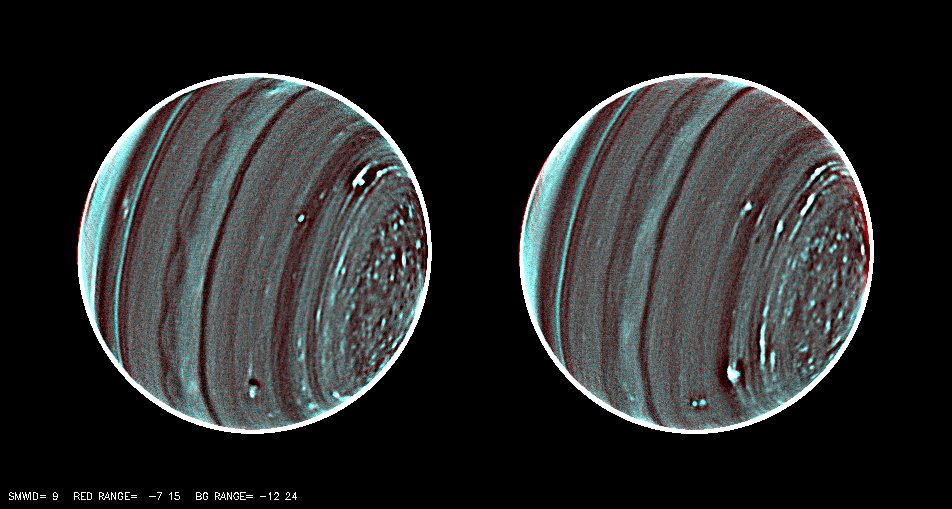Uranus from the Great Observatories
| Uranus from Damian Peach (2013) |
In 2013 Uranus and Neptune are truly within reach of the most talented amateur observers, with observers able to see the polar collars of Uranus in strong methane absorption (e.g., this image from Damian Peach) and track distinct bright storm-like features on Neptune (e.g., the excellent blog from Christophe Pellier). However, in the absence of any dedicated ice giant missions, today or in the near term, we rely on the resources of the 'great observatories' to reveal new insights into the composition of Uranus and Neptune. Cavalie et al. (DPS & EPSC) used the Herschel Space Observatory to detect CO in the Uranian atmosphere, using the sub-mm spectra to understand the potential origins of this stratospheric species - material from icy rings/satellites, interplanetary dust or potentially large cometary impacts (such as CO in Jupiter's atmosphere after the Shoemaker Levy 9 collision, Bezard et al., 2002). Fry & Sromovsky (DPS) report Hubble observations of Uranus from September 28th 2012 using STIS to measure spectra from 0.3-1.0 µm now that the north pole is coming into view (we passed Uranus' spring equinox in 2007). These observations indicate that methane depletion at mid-to-high latitudes in Uranus' troposphere is symmetric about the equator - i.e., it's not seasonally-forced like the atmospheric brightness or discrete cloud features. This high-latitude depletion of methane has implications for how Uranus' atmosphere redistributes material from equator to poles. Finally, Moses et al. (DPS) interpret the equinoctial Spitzer observations of Uranus by Orton et al., using a photochemical model to interpret the relative abundances of the soup of hydrocarbon and oxygenated species in Uranus' stratosphere.
 |
| Uranus in July 2012 from Keck II telescope. |
Improvements of adaptive optics (i.e., giving better spatial resolution) and spectral resolution in diagnostic wavelength bands means that ground-based observatories also plug the remote sensing gap for the ice giants. Irwin et al. (EPSC) presented near-IR images and spectroscopy of both ice giants from Gemini and VLT in 2009, finding similarities in the scattering properties (and hence composition) of their main 2-3 bar cloud decks, and near-identical deuterium-to-hydrogen ratios suggesting that these two worlds shared a rather similar origin. Tice et al. (EPSC) used an integral field unit (SWIFT) with Palomar's AO system to produce high-resolution 0.65-1.0 µm spectra of Neptune, using them to investigate the latitudinal distributions of clouds and methane on the most distant ice giant. Roman et al. (DPS) presented H- and K-band images and spectra of both planets from Palomar between 2001 and 2007, using them to determine the distributions of clouds, aerosols and para-hydrogen (a tracer of atmospheric motion and chemical equilibriation). de Pater et al. (DPS) report a multi-wavelength campaign of near-infrared, thermal-infrared and microwave observations of Neptune from Keck and the VLA in 2003, particularly focussed on the warm temperatures and volatile depletion near the southern summer pole. In a similar vein, Norwood et al. (DPS) use microwave observations to determine the chemical abundance of Neptune's troposphere (e.g., the volatiles H2S and NH3). Iino et al. (EPSC) used 2010 observations from the 10-m NOAJ Atacama Sub-Millimetre Telescope Experiment (ASTE) to measure CO, HCN and CS (not detected) in Neptune's atmosphere, and show that the ratio of CS to CO is 300 times smaller on Neptune than on Jupiter, casting doubt on ideas of cometary origins for Neptune's atmospheric composition.
Beyond the observations, numerical models are attempting to understand how an ice giant atmosphere circulates, and how this differs from the gas giants. Sussman et al. (DPS) explored the dynamics of planets with axial tilts exceeding 54 degrees (i.e., the poles receive a greater insolation than the equator when averaged over a year), and showed how the fine balance between thermal gradients and Rossby wave generation and propagation governs whether you'll get eastward or westward jets at mid-latitudes. The remarkably uniform temperature gradient on Uranus suggests that the mechanisms transporting heat latitudinally are rather efficient. Kaspi et al. (DPS) report on their recent Nature article, using the gravitational fields of the ice giants (particularly the fourth gravity harmonic determined from Voyager and HST observations) to constrain the atmospheric 'weather' to the outermost 0.15% of the mass on Uranus and 0.2% on Neptune (i.e., a thin layer no more than 1000 km thick). Finally, Friedson (DPS) discusses reasons why the heat flux from an ice giant might be small - water is sufficiently abundant in its condensation zone that both 'ordinary' and 'diffusive' convective transport are inhibited (i.e., the layer is stable), limiting the transport of heat to nothing more than a weak, oscillatory convection which does a poor job at moving energy upward through these atmospheres.
Looking to the Future
With ESA's next round of large-class cosmic vision proposals just around the corner, interest in an ice giant mission was strong throughout 2013, with three white papers (Uranus Pathfinder by Arridge et al., a Neptune mission from Masters et al., and the dual ODINUS concept from Turrini et al.) submitted for the call for science themes, not to mention my own efforts with Olivier Mousis for an ice giant entry probe. Along with several others, I helped organise a 3-day workshop in Paris in September called "Uranus Beyond Voyager 2" - the rich discussions from this meeting were summarised in a recent blog post by Geraint Jones. Hopefully the community will build on these new scientific results and collaborations as we prepare to respond to new ice giant mission calls in 2014 and beyond!
No comments:
Post a Comment